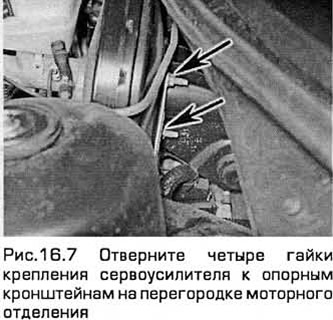Examination
1. To check the operation of the servo booster, press the foot brake pedal several times to eliminate the vacuum. Then start the engine while keeping the pedal depressed. When starting the engine, you will feel "quickdraw" pedals with increasing vacuum. After the engine has been running for a while (at least a couple of minutes), mute it. Now, pressing the pedal, you will hear a whistling sound coming from the servo amplifier. After four or five presses, this sound should stop and the pedal should become "tougher".
2. If the servo does not work as described above, then first of all, you need to check the non-return valve of the servo (see paragraph 12).
Withdrawal
Models with 4-cylinder engines
3. Remove the master cylinder (paragraph 11).
4. Remove the air cleaner and intake duct (chapter 4A).
5. On models with an air conditioning system, remove the bolts of the refrigerant piping brackets near the servo booster and move the brackets to the side.
6. Disconnect the vacuum hose adapter from the servo by pulling it out of the rubber grommet. If it is difficult to pull it out, then pry it with a screwdriver under the flange.
7. Unscrew the four nuts securing the servo amplifier to the support brackets on the bulkhead of the engine compartment (see fig. 16.7).

8. On right-hand drive models, slide the servo amplifier until its studs come out of the brackets. Have an assistant keep the brake pedal depressed. Then pull out the elastic retainer and remove the finger (who held this latch) attaching the servo pushrod to the pedal link arm.
9. On left-hand drive models, unscrew the nut that secures the pedal trunnion to the servo booster pusher inside the passenger compartment. This nut is installed near the top of the pedal. It can be unscrewed through a special access hole.
10. To improve access, first remove the bottom panel from the front panel.
11. Remove the servo amplifier from the bulkhead and remove it from the engine compartment.
12. On left-hand drive models, be careful not to damage the baffle rubber bushing when you retract the pushrod through it.
13. Please note that the servo amplifier cannot be repaired and must be replaced if it fails.
Models with V-shaped 6-cylinder engines
14. Disconnect the accelerator and cruise control cables from the throttle body (chapter 4A).
15. On models with automatic transmission, remove the two bolts securing the transmission selector cable bracket. Disconnect the end of the cable and move the cable to the side.
16. Disconnect the engine wiring connector (if it hasn't been done before) located in front of the servo amplifier assembly.
17. Disconnect the injection and drain fuel lines from the fuel line (chapter 4A).
18. Disconnect the main wire from the starter (chapter 5A).
19. Remove the servo amplifier from the bulkhead and remove it from the engine compartment. On left-hand drive models, be careful not to damage the baffle rubber bushing when you retract the pushrod through it.
20. Please note that the servo amplifier cannot be repaired and must be replaced if it fails.
Installation
21. Installation - in the reverse order of removal. When removing the master cylinder, see paragraph 11.
Visitor comments